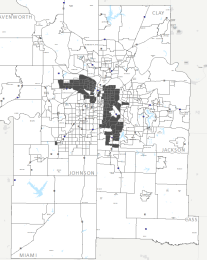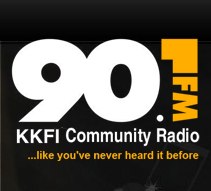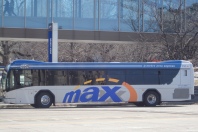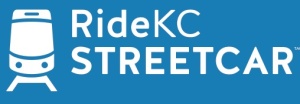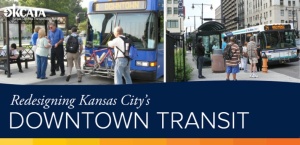2014 was a busy transit year and it is fun to look back to see some of the main stories and think about the future. Links to some of our related posts are included. If you want to get actively involved in on-going transit issues, contact us at TransActionKC@gmail.com or attend our first meeting of 2015 at Noon on January 9th at the KC Central Library at 10th and Baltimore.
1. The Downtown Streetcar
The Downtown Streetcar construction got underway in May and is about one-third complete at year end. Check out KCStreetcar.com for updates. 
Tom Gerend, previously the Assistant Director of Transportation at MARC, was named the Executive Director for the Streetcar Authority.
Please support the businesses along the route. Lunch Mobs are being organized to help these businesses. Check out @kcstreetcar @tacticalurbankc
2. The Streetcar expansion
Kansas City’s August election for three streetcar expansion routes (Independence Avenue, Linwood and Main Street) would have added an additional 7.6 miles to the Downtown Streetcar for a total of 9.8 miles. The Prospect MAX recommendation was 9.1 miles long. Streetcar Steering Committee Releases Recommendations and Draft Report The proposal lost 60%-40%. Video – KC Streetcar Expansion Election Watch and Mayor’s Speech
 Read the final Next Rail report if you aren’t familiar with the Main Street expansion to the Plaza. If the city comes up with a good funding plan, the expansion to the Plaza may be seen again in a couple of years. Next Rail final expansion recommendation
Read the final Next Rail report if you aren’t familiar with the Main Street expansion to the Plaza. If the city comes up with a good funding plan, the expansion to the Plaza may be seen again in a couple of years. Next Rail final expansion recommendation
3. KCMO continues to withhold $2.5 million from KCATA
Although the Kansas City budgeted 95% of the revenue from the ½ cent Transportation Sales Tax to KCATA based on an ordinance TAN initiated in 2010 (it was updated in 2013), the city is withholding $2.5 million from KCATA and causing KCATA’s reserve account to deplete even faster, which is ironic since the city says it is concerned that the KCATA reserve account will deplete itself before 2022; currently estimated to run out in 2018. The city is over $5 million short in its payments to KCAT̄A this year caused by the combination of insufficient sales tax revenue and the additional amount being withheld. KCATA expects the city to short them $5.4 million in 2015.
TAN hopes KCMO pays its bills to the best of its ability by the end of this fiscal year, April 30, 2015. The city administrator is holding the money in case he decides to start out-sourcing part of the bus system to save money. More in 2015.
4. KCATA
KCATA is working on a comprehensive service analysis to re-design transit downtown. Attend Public Meetings – Redesigning Downtown KC Transit – July 17 and Downtown Service Improvement Concept

Map Of Downtown Concept
KCATA continued it re-organization A New Vision for KCATA and KCATA General Manager Mark E. Huffer Resigns KCATA is currently looking to fill a new CEO position.
The year ended with KCATA Board of Commissioners re-electing Robbie Makinen for another year as Chair since the reorganization for KCATA isn’t finished and Makinen is doing such a great job pushing the agenda forward. Congratulations! Robbie Makinen Elected KCATA Chair Again
5. TAN RADIO
Transit Action Network started a semi-regular “Transit Talk” show on 90.1 FM KKFI Kansas City Community Radio on the Radio Active Magazine show. This magazine show has numerous activist groups taking turns to inform the community on various issues. TAN Radio archive of previous shows Interviews covered conversion to CNG buses, a MAX line for Prospect Ave, the KC Streetcar/MAX election ballot, the MO Amendment 7 election, Special Transportation issues, our inability to pay for most rail projects (like rail to the airport), and a talk with Robbie Makinen about changes at KCATA.

KKFI operates a 100,000-watt transmitter, the most powerful allowed by FCC regulations.
The next show is Jan 6 at 6pm on 90.1 FM KKFI – Your Civil Rights Related To Transit – What are they and how to protect them!
6. Sense or Nonsense –New TAN series
Sense or Nonsense? Streetcars and Increased Property Values Sense or Nonsense? Does rail increase property values? MAKES SENSE
Sense or Nonsense? Streetcars and Development Only light rail systems generate development. NOT SO.
7. New TAXI style services in KCMO
The KCMO city council started the year by changing the taxi ordinance to allow Independent Transportation Network® (ITN), a non-profit charitable organization to operate a vehicle for hire to transport persons who are 65 years of age or older or visually impaired. Action Alert: KCMO – Please Allow A New Transit Service For The Elderly and Visually Impaired
Uber and Lyft, App driven ride-sharing services, arrived in KC. Uber received a license to operate, but Lfyt is having legal problems.
REGIONAL TRANSIT ISSUES
It is important to remember that we need better transit throughout the whole region.
A. Regional Transit Coordinating Council (RTCC)
- The RTCC decided to tackle tough issues: RTCC Tackles Big Transit Issues – Funding and Paratransit
RTCC requested and received more money for transit projects from allocations of federal money (STP and CMAQ) than has ever been granted, including $10 million allocated for Jackson County purchasing the old Rock Island line and two additional railway spurs from Union Pacific.
- There are two groups to advise RTCC: Transit Stakeholder Forum (TSF) and the Mobility Advisory Committee (MAC).

The TSF is totally open to the public, vague, and doesn’t have members or regular meetings.
We understand that allowing everyone to participate is a new concept at MARC and KCATA, but we think this one needs more work. The forum is very top down and is doesn’t meet regularly like MAC, which meets every other month.
- Why wasn’t TSF asked for input on the RTCC 2015 workplan? It got to comment on the 2014 plan.
- When transit projects were developed and prioritized by RTCC for STP and CMAQ funding, the TSF didn’t even get to look at them. (MAC got to prioritize $6 million in funding requests and actually function like an advisory committee-see below)
- Why isn’t there time for riders to address their issues with the transit agencies?
- When will TSF function more like a substantive advisory committee?

MAC, on the other hand, has had only had two meetings, but they are developing a very large membership with voting rights, and they have already recommended a multi-million dollar list of projects to RTCC for allocating 5310 federal funds for paratransit/senior capital and operating money. True, MAC is basically reconvened from the old Special Transportation/JARC Committee at MARC, so they are bringing in the same people as before and expanding.
Mobility Advisory Committee Meets Dec 10
- RTCC is leading a regional branding effort that will be rolled out in 2015: RideKC.
B. Seamless Transit Advocacy
Transit Action Network believes the transit system should function in a seamless fashion so that it appears to be run by one agency. We are pleased that the seamless transit concept continues to gain steam. Besides our list of specific seamless transit suggestions Seamless Transit In the Kansas City Region, we advocate for the election of transit friendly public officials and encourage municipalities to return to KCATA for management or management/ operations, which provides the best opportunity for eliminating barriers between the transit systems (The barriers aren’t due to the jurisdictional BORDERS; the problems are caused by operational and infrastructure differences between the transit agencies)
- Johnson County
JoCo was in the spotlight at the end of the year with a big county election and a decision to return transit management of The JO and Special Edition to KCATA after 30 years.
Online Transit Forum – Candidates for Johnson County Commission
Big Win for Seamless Transit – The JO Returns to KCATA
- Wyandotte County and Independence
 During the year TAN met with Mayor Weir of Independence, Mayor Holland of Unified Government of Wyandotte County and several UG commissioners. Although we advocated for a wide range of transit issues, including better seamless transit, our main thrust was to encourage both entities to bring the rest of their transit service under the management or management/operations of the re-organized KCATA, like Johnson County recently decided. We hear rumblings that this process might start.
During the year TAN met with Mayor Weir of Independence, Mayor Holland of Unified Government of Wyandotte County and several UG commissioners. Although we advocated for a wide range of transit issues, including better seamless transit, our main thrust was to encourage both entities to bring the rest of their transit service under the management or management/operations of the re-organized KCATA, like Johnson County recently decided. We hear rumblings that this process might start.
- Jackson County
Jackson County reached an agreement with Union Pacific for an “option to purchase” the Rock Island right of way plus two spurs for $59.9 million. Jackson County Option to Purchase press release. The agreement has been extended to Sept 2015. Although the County has received $10 million from a federal grant (see RTCC), the County still needs another $50 million for the purchase and that money isn’t easy to come by.
 This corridor will make a great addition to the Katy Trail, but it showed extremely low ridership for commuter rail in the Jackson County Alternatives Analysis. Ridership between 500 and 1000 trips per day were projected and the line would not qualify for FTA New Starts money at this point. (The Prospect bus has over 6,000 trips daily and it isn’t even a MAX line.)
This corridor will make a great addition to the Katy Trail, but it showed extremely low ridership for commuter rail in the Jackson County Alternatives Analysis. Ridership between 500 and 1000 trips per day were projected and the line would not qualify for FTA New Starts money at this point. (The Prospect bus has over 6,000 trips daily and it isn’t even a MAX line.)
During 2014 TAN made presentations on financing alternatives for commuter rail and the purchase of the Rock Island property to Jackson County officials. Discussions are continuing.
- Unified Government New Transit Route #105 and Bigger Buses to #101
Mayor Holland promised TAN to provide bigger buses to alleviate crowding once the #101 became the new CONNEX service. The improved service went into effect in January 2014. State Ave. CONNEX Gets Big Buses Jan 5

Erin, Carol, Carroll and Rachel conducting the Rosedale Transit Survey
The Rosedale Development Association and the KCK community, along with TAN, secured the new Rosedale Route #105. Event: Opening of 105-Rosedale Route June 30
- C. Environmental Justice Analysis and Tiger Grant
TAN has been in discussions with MARC staff about changes to their Environmental Justice Analysis, which studies how federal transportation money is spent in the region relative to minorities and low-income populations.
The Brookings Institution found that only 18 percent of jobs in the KC region are reachable via transit in 90 minutes or less — ranking the Kansas City region 90th of the 100 largest metros. From a civil rights perspective, we may not be meeting the needs of minorities and low-income populations to get to work by transit. With such a low rate, we probably aren’t meeting the transit needs of the whole community. Meeting the needs of minorities and low-income populations should be included upfront in any assessment for transportation planning.
MARC received a $1.2 million TIGER planning grant to STUDY the situation. The goal of KC Workforce Connex is doubling transit access to jobs over the next 10 years. A major study area will be along the I-435 corridor between the new Cerner campus and I-35 in Johnson County, which includes the busiest commuter corridor in the region, yet doesn’t have any transit.
D. MO Sales Tax For Transportation Failed
Transit Action Network believes Missouri shouldn’t pass a constitutional amendment to radically change the way we pay for roads and bridges
We spent several months working against this ballot initiative of a 3/4-cent sales tax for transportation, so we were pleased when it failed in August.
Video, Podcasts, Cartoon – VOTE NO On MO Amendment 7
However, the funding issue for roads isn’t resolved. Raising the gas/diesel taxes is the easiest and cheapest method to administer and probably the smartest option, but Governor Nixon has asked for a study to investigate tolling on I-70. That starts 2015.
Happy New Year and join us in advocating for better transit in our region.
 For decades, road projects have dominated the allocation of federal transportation money in the Kansas City metropolitan area. Money allocated for transit did not resolve the lack of regional access for jobs, medical care or education. Usually the transit allocation share was too small, often only 5% of the available federal funds.
For decades, road projects have dominated the allocation of federal transportation money in the Kansas City metropolitan area. Money allocated for transit did not resolve the lack of regional access for jobs, medical care or education. Usually the transit allocation share was too small, often only 5% of the available federal funds.